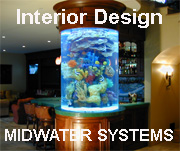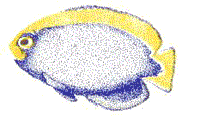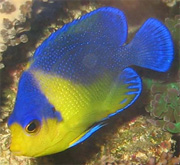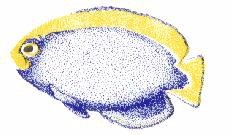|
THE CRUSTACEANS,
DOCILE SPECIES (SHRIMPS)
By Jim Wolf Marine Biologist
This group of crustaceans shares some characteristics that help us to
lump them into one category. Most of the following species are not too
aggressive, and all have there abdomen sticking out behind their cephalothorax
(unlike crabs).
Most of these animals can live well with other members of their species.
Their claws are often small, and many species can be sexed, with the males
often being either smaller, or having larger claws than the female. All
of the shrimps will accept a variety of foods, just try to insure that
they can get some food. Try feeding bits of food directly or maybe feed
at night for the first few feedings to help the shy specimen along.
The following is a list of specific genera, and some of their requirements.
Lysmata This is the genus of the familiar Cleaner Shrimps. They
are slender bodied with very small claws. They are social, and harmless.
Under good conditions they will actively clean the parasites off fish.
Stenopus are the Barber-Pole or Boxer Shrimps. They share many
with features with Lysmata but they grow much larger, and do best either
singly or in pairs.
Saron and Rhynchocinetes are the genera of the Marbled and Dancing
Shrimps respectively. These shrimps share many features and are so
lumped together. They are shy and nocturnal, shun bright light, do good
in groups, and the males typically have larger claws. The Dancing Shrimps
can be displayed nicely by creating a small cave of lava rock, to which
the will cling to the inside roof of. Saron shrimps like similar conditions,
but will stay on the bottom of the cave, amongst small patches of gravel
and algae. Some members of these genera are known to consume certain species
of corals.
Periclimenes is the genus of the fragile and beautiful Anemone Shrimps.
They
form an intimate bond with a specific anemone or other cniderian. Great
care should taken when introducing these animals as they are quite shy
and fragile. Provide a host cniderian that closely matches their background
color. Once with their host, the will feed from food caught by their host,
and do quite well.
Hymenocera are the curious Harlequin Shrimps. These comical animals
do good in pairs, and have a strange diet. They eat starfish. About every
2-3 week a small starfish should be provided, with the genus Linkia (Blue
Stars) being the best. Remove the starfsh after signs of decay are obvious.
Take great care in acclimating your new shrimp to the aquarium. Make
sure that you not only consider salinity and temperature, but the habitat
and other tank mates. Try to provide the specific niche that your specimen
requires. Introduce them by opening the bag (after temperature and salinity
are with in acceptable limits) and gently place them near the desired location.
Low light intensity, and insuring the other tank mates are not too close
or hungry will help these docile creatures out a lot.
|











